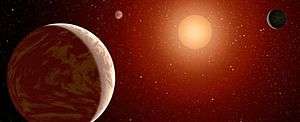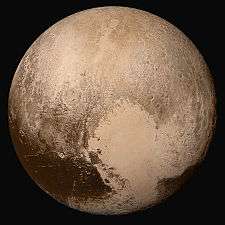Wolf 1061c

An artist's impression of Wolf 1061c orbiting in a triple exoplanet system
[2]Wolf 1061c or WL 1061c is an exoplanet orbiting within the habitable zone of the red dwarf star Wolf 1061 in the constellation Ophiuchus, about 13.8 light years from Earth, making it the closest known potentially habitable planet to Earth.[2][3] It is the second planet in order from its host star in a triple planetary system, and has an orbital period of 17.9 days. Wolf 1061c is classified as a super-Earth exoplanet as its estimated radius is greater than 1.5 R⊕.
Characteristics
Wolf 1061c is thought to be a rocky planet estimated to be a super-Earth exoplanet as its mass is about 4.3 times that of Earth and radius is over 1.5 which would give it a density either near or possibly higher then earth.[4] It has an orbital period of 17.9 days,[5] and an estimated surface gravity of 1.6 times that on Earth.[5]
In astronomical terms, the Wolf 1061 system is relatively close to Earth, at only 13.8 light years away. This makes it the closest known potentially habitable planet to Earth, yielding interest from astronomers.[2][3]
The discovery was announced on 17 December 2015, following a study that used 10 years of archival spectra of the star Wolf 1061 using the HARPS spectrograph attached to the ESO 3.6 m Telescope at the European Southern Observatory at La Silla, Chile.[2][5]
Habitability potential
The planet's orbital distance of 0.084 AU (assuming mild eccentricity) lies at the inner edge of its star's habitable zone, which extends from approximately 0.073 to 0.190 AU (for comparison, the habitable zone of the Sun is approximated at 0.5 to 3.0 AU for its different energy emission).[6] Because it is so close to the star, it is likely to be tidally locked, meaning one side permanently faces the star and the other side permanently faces away. Although this scenario could result in extreme temperature differences on the planet, the terminator line that separates the illuminated side and the dark side could potentially be habitable, as the temperature there could be suitable for liquid water to exist.[7] Additionally, a much larger portion of the planet could also be habitable if it has a thick enough atmosphere to facilitate heat transfer away from the side facing the star.[3] According to PHL Wolf 1061c's ESI is only 0.76 comparable to that of Gliese 581 g, KOI-2474.01, KOI-2469.01 and KOI-2992.01. Wolf 1061c ranks as of January 2016, fourth for planets in the conservative habitable zone and overall, including planets located in the optimistic habitable zone, Wolf 1061c would not even be in the top ten for Earth similarity.[1]
See also
References
External links
 |
Wikimedia Commons has media related to Wolf 1061. |
|
|---|
| | Disciplines | |
|---|
| | Topics | |
|---|
| Space
missions | Earth satellites | |
|---|
| Mars missions | |
|---|
| Deep space | |
|---|
| Planned | |
|---|
| Proposed | |
|---|
| Cancelled | |
|---|
|
|---|
| | Related | |
|---|
|
-
 Category Category
-
 Portal Portal
|
|
|
|---|
| | Primary member type | Celestial objects by systems. Secondary members are listed in small print. |
|---|
| | | | | | | | | |
|




